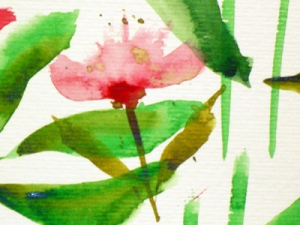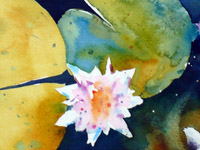
Watercolour: the power of water
For approximately 32 000 years, the man has used pigments and water to express himself. If since this time the motivations which have urged him to express himself in that way are not any more the same, the fact remains that this practice of watercolour lives and fluids more and more followers, even if watercolour is still qualified as difficult.
Then, would watercolour be the first pictorial technique? Maybe not in the sense which we grant it today, but r finds its origins in prehistorically times, because it is indeed thanks to some water and pigments stemming from the ground that were born the first forms of parietal pictorial art. The first one also because it is by watercolour and aquarellable inks that the child expresses himself before learning how to write. The first one also because it is often at the origin of more ambitious works executed in the oils; this is maybe the reason why some elitist and compartmentalized spirits are used to considering watercolour just as a preparatory exercise to “the work”.
Nevertheless, painters such as Claude Lorrain, Vladimir Kandinsky, and also Blanche Odin, or still Eugène Delacroix, such famous painters who gave watercolour its renown. Then, which plea for watercolour to put it in the right place among the different mediums that the artist has at his disposal to express his vision of the world? After all, what is watercolour? What differentiates watercolour from a simple water paint? Where does watercolour’s specify comes from?

It is true that the technique of watercolour is considered as difficult because independently from any artistic criterions, the beginner has to control water to reveal its qualities and bring it to the same rank as the other mediums. Water is the fear of the beginner. He might put too much painting (flatness of colours, absence of tonal values, blotches and unwanted borders) or not enough (effect of gouache, no transparency).
Water… how can the painter estimate the quantity of water to load in the brush (active water), on the paper (passive water); when does the painter have to intervene to put the pigments so as to avoid the unwanted effects such as certain blotches, and to obtain a blending, a graduated effect, a deliberate blotch?
So clearly, the difficulty of watercolour is in the control of the cycle of water (E. Karpinska). And the cycle of water, from the stage of drop lens-mirror to the dry stage has discouraged a lot of uninitiated, which is the reason why watercolour is often considered with contempt as a water painting technique.
Unfortunately, for uninitiated people, watercolour is just painting diluated in some water; and water is considered just as a solvent. Whereas, it is an element as important as painting and the line. Water is the key of this technique to express an atmosphere, a feeling.
To paint in watercolours, you need to get the gripps with water and understand the different stages of its cycle, because water will give you the rhythm of the watercolour as soon as water is applied on the paper. Water has the power over the time to take action. You need to know perfectly water’s reactions to succeed in painting in watercolours. It is at that moment that comes into play colored pigments loaded in the brush with more or less water, according to the effect you wish for.
From that moment, watercolour arouses surprise, delight, curiosity, when water and pigments set going on the white, horizontal or oblique paper, sweeping along the pigments which blend into puddles. Watercolour turns into a living, unstable and stirring environment which evolves throughout the cycle of water. And the paper is transformed into an athanor in which alchemy works out and transforms “earth” into light;
The painter sees and takes part in a real modelling of pigments under the effect of water. The brush sculpts watercolour and creates gullies stages after stages.
Then pigments sculpts the light and let more or less reflect itself on the paper throughout the successive glazing (technique of wet on dry) according to their transparency degree or the surfaces of unting in which pigments blend one another (technique of wet in wet) in a monochrome of colours in order to “make color sing” (J. Dobie) and to reveal the light of water (E. Karpinska). There are some who like to say that oil painting is certainly the most adapted technique to succeed in alla prima… that is not sure. It is sure that oil painting remains wet longer than the other mediums. Oil painting also makes touching up and superimpositions possible. So, this is not alla prima yet.
Alla prima is “straight away”. It is true that watercolour painting as well as in oil painting can be executed right away too, without any preparation on the paper and reveal its qualities by this process with spontaneity. But make no mistake, watercolour painting is a long and patient work, it is an apprenticeship in which the painter takes pleasure in learning, by gesture and observations, the development of pigments and water to express his feelings and emotions.
The work of a painter is a following of failures and success. He has to make choices and take decisions to succeed in painting not what he sees but what he thinks: “Painting what you want to see” (Ch. Reid). It consists in a mental working out.
It is impossible to control watercolour. The painter needs to learn how to get the gripps with watercolour. Water is like an animal which needs to be tamed to become closed to it, while it is still conserving its traps: alchemy occurs and the “Big Work” is archived. Here is the difference between watercolour painting and oil painting. Oil is only a solvent which disappear once painting is applied, while water keeps up in the washes and glazing loaded with earth pigments like a memory of its presence. A watercolour painting, once it is finished and dry, needs to transpire water, like a drained earth previously eroded by the flow of the rain and keeps the track of water which created gullies and sedimentations. That is typical of the passage of water even evaporated, like a royal seal which reveals all the specificity of watercolour. To make the choice of watercolour is like fitting into the road of water (JC Chaillou) and choosing the “creative water” (JL Morelle) which is an added element which not only serve thin down the earth pigments, to model and to till it. That is the reason why in watercolour painting, water has a fundamental importance to reveal what characterizes watercolour: luminosity and transparency.








